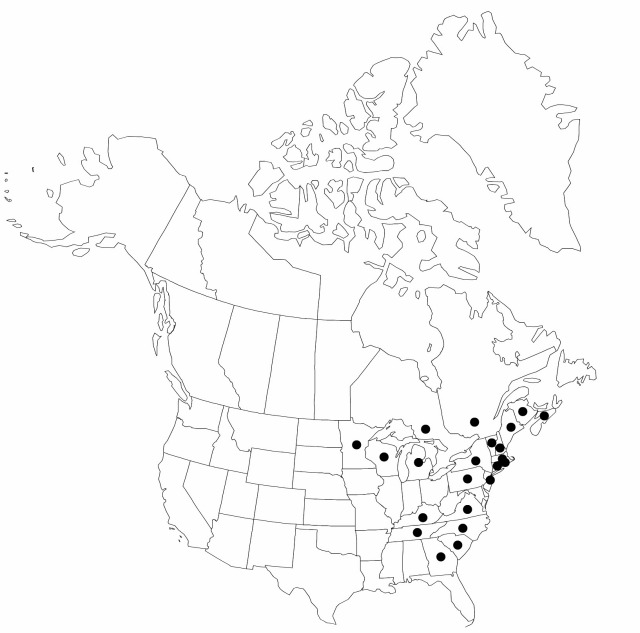Carex lucorum
Enum. Hort. Berol. Alt. 2: 380. 1822.
Plants loosely cespitose; rhizomes horizontally spreading, pale-brown to reddish-brown, (5–) 20–80 mm, slender. Culms 7–55 cm, scabrous distally; bases (remnants of old leaves) fibrous. Leaf-blades pale to dark green, 0.7–3.6 mm wide, herbaceous, papillose to scabrous abaxially, papillose to scabrous adaxially, blades of distal cauline leaves poorly developed. Inflorescences with both staminate and pistillate spikes; peduncles of staminate spikes 0.7–13 mm; proximal nonbasal bracts leaflike, shorter than inflorescences. Spikes: proximal pistillate spikes 1–3 (basal spikes 0); cauline spikes overlapping or somewhat separated, with (2–) 3–13 perigynia; staminate spikes 8–22.5 × 1.4–4.6 mm. Scales: pistillate scales pale or usually dark reddish-brown, with narrow white margins, ovate to lanceolate, 2.7–4.3 × 0.8–2.4 mm, apex acute to long-acuminate; staminate scales obovate to lanceolate, 3.7–6.1 × 1–1.4 mm, obtuse to acute or acuminate. Anthers 1.9–4.6 mm. Perigynia yellowish green to pale olive, veinless, obovoid, 2.7–4.6 × 1.2–1.7 mm, as long as wide; beak straight, pale green to olive, occasionally with reddish-brown tinge near apex, 0.9–1.6 mm, weakly ciliate-serrulate, apical teeth 0.1–0.6 mm. Stigmas 3. Achenes dark-brown, obovoid to globose, obtusely trigonous in cross-section, 1.3–2.2 × 0.9–1.6 mm.
Distribution

N.B., N.S., Ont., Que., Conn., Ga., Ky., Maine, Mass., Mich., Minn., N.C., N.H., N.J., N.Y., Pa., R.I., S.C., Tenn., Va., Vt., Wis.
Discussion
Varieties 2 (2 in the flora).
Selected References
None.
Key
| 1 | Leaves usually 1.5+ mm wide; northeastern North America. | Carex lucorum var. lucorum |
| 1 | Leaves usually less than 1.5 mm wide; Appalachian Mountains of southern Virginia to Georgia. | Carex lucorum var. austrolucorum |
"shortened" is not a number.No values specified.